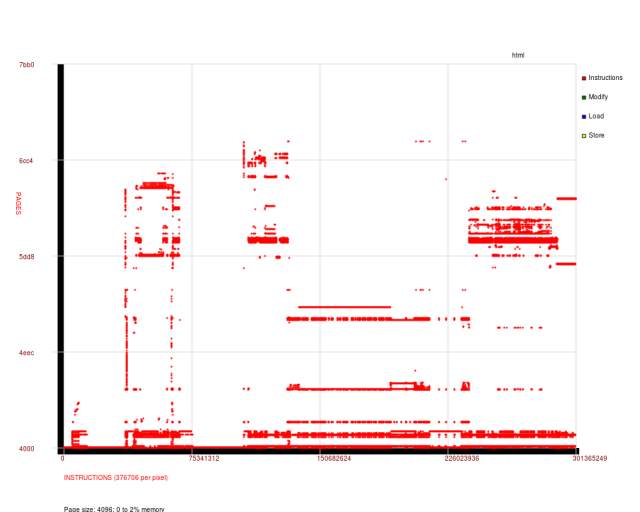I am generating a lot of the graphics for my project using Scalable Vector Graphics (SVG) – an XML
format.
The advantages of SVG are obvious – it is human readable, it preserves some of the data in the output (eg in the relative placing of the dots on a graph), Groovy has good support for it and, in theory at least XML Stylesheet Transformations (XSLT) means that it can be manipulated outside of a formal programming environment using another bit of XML (an XSL stylesheet) and freely available XSLT tools – eg xsltproc on Linux.
But XSLT is one of those Cinderellas of the computing world – widely relied on but not generally understood or widely discussed. As a result I have struggled over the last 24 hours to work out how to do what ought to be a simple thing: removing a set of dots of one colour from an SVG. I still have not got to the bottom of all the issues – specifically xltproc seems to have an issue with XML namespace declarations and/or DTD declarations – but I have fixed it for all practical purposes, so thought I should document it for future users…
Before I describe the problem more fully as well as the solution, I have to recommend this book – XSLT: Mastering XML Transformations. For Beginners and Advanced Users – which gave me the pointers to a solution I just could not find online.
So here is the graph (in PNG format because WordPress does not support SVG) I want to manipulate.
 This is memory map – via Valgrind – of Firefox (7) opening and closing (I created a page that, once Firefox was configured, would close the browser.)
This is memory map – via Valgrind – of Firefox (7) opening and closing (I created a page that, once Firefox was configured, would close the browser.)
The different types of memory accesses – for instructions (red), loads (blue), stores (yellow) and modifies (green) are all on superimposed and which colour you see depends on the order they are written if they access the same page.
So the answer, with an SVG, is obvious, just look at the colour you want to see.
Ought to be easy, right? Well, I suppose when you know how to do it, it is easy. But it’s not completely simple!
Each dot on the graph is drawn with an XML element like this:
<circle cx='102' cy='699' r='1' fill='none' stroke='red' stroke-width='1' />
The trick is to create a template for all the elements but inside that template only copy out the elements that match the correct stroke attribute. (Attributes are not children of node elements either, so you have to copy them out explicitly.)
Here’s a stylesheet that does it:
<?xml version="1.0"?> <xsl:stylesheet version="1.0" indent="yes" xmlns:xsl="http://www.w3.org/1999/XSL/Transform"> <xsl:param name="colour">yellow</xsl:param> <xsl:template match="/"> <xsl:apply-templates select="svg"/> </xsl:template> <xsl:template match="svg"> <xsl:copy> <xsl:for-each select="@*"> <xsl:copy/> </xsl:for-each> <xsl:text> </xsl:text> <xsl:apply-templates select="rect"/> <xsl:apply-templates select="line"/> <xsl:apply-templates select="text"/> <xsl:apply-templates select="circle"/> </xsl:copy> </xsl:template> <xsl:template match="line"> <xsl:copy> <xsl:for-each select="@*"> <xsl:copy/> </xsl:for-each> </xsl:copy> <xsl:text> </xsl:text> </xsl:template> <xsl:template match="rect"> <xsl:copy> <xsl:for-each select="@*"> <xsl:copy/> </xsl:for-each> </xsl:copy> <xsl:text> </xsl:text> </xsl:template> <xsl:template match="text"> <xsl:copy> <xsl:for-each select="@*|node()"> <xsl:copy/> </xsl:for-each> </xsl:copy> <xsl:text> </xsl:text> </xsl:template> <xsl:template match="circle"> <xsl:if test="@stroke=$colour"> <xsl:copy> <xsl:for-each select="@*"> <xsl:copy/> </xsl:for-each> </xsl:copy> <xsl:text> </xsl:text> </xsl:if> </xsl:template> </xsl:stylesheet>
(This code be shortened to just copy-of the line, rect and text elements.)
And here’s an example:
xsltproc -o inst.svg --stringparam colour "red" pickcolour.xsl master.svg

One response to “Using XSLT to manipulate an SVG file”
Thank you Adrain for sharing your learning process, I would add that xslt is actually fairly easy to master and there are some good tutorials on the w3schools site here; http://www.w3schools.com/xsl/ thanks again!